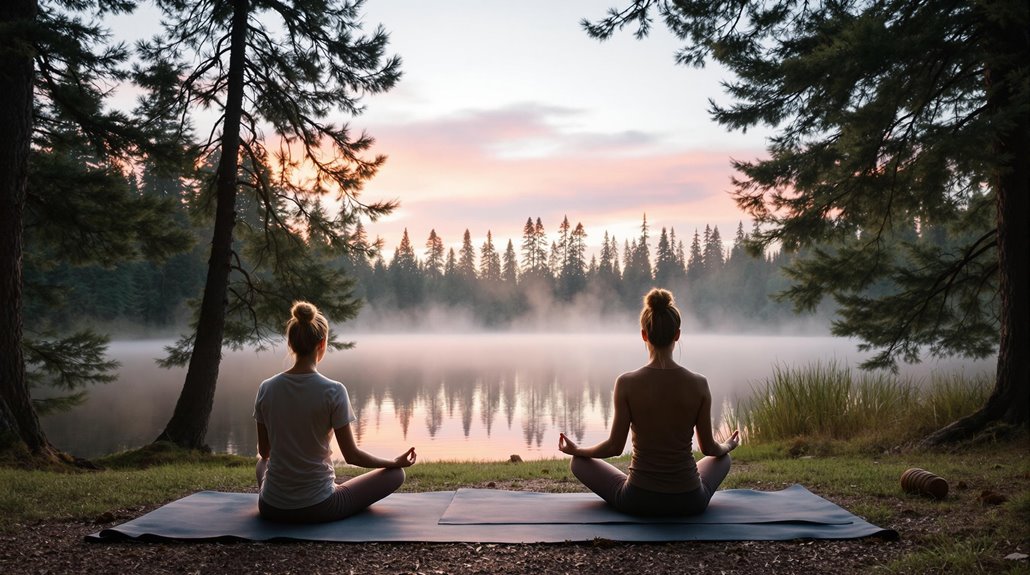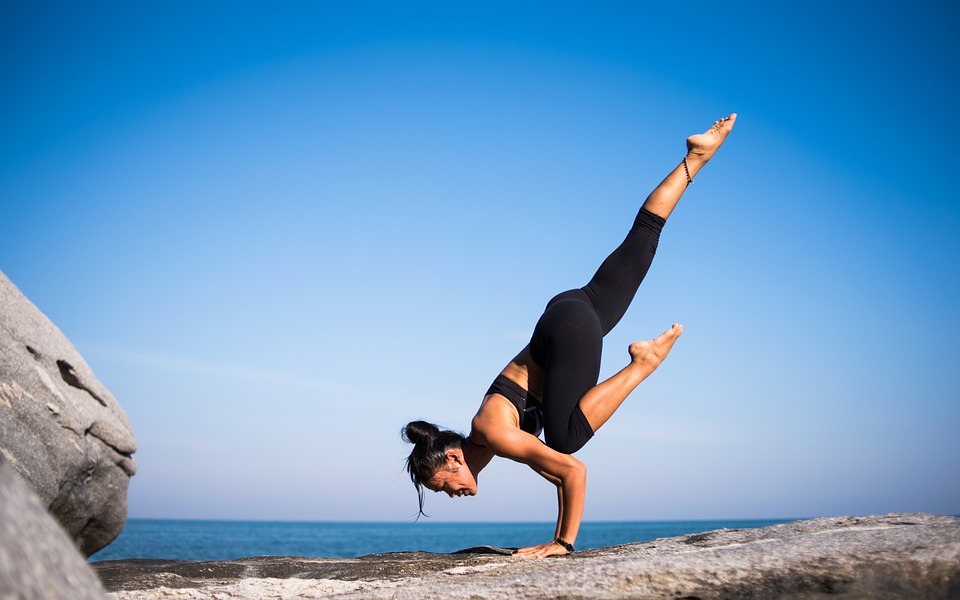
To ease stress, try mindfulness meditation and deep breathing exercises. These practices, like the 4-7-8 Breath and cyclic sighing, calm your nervous system and enhance emotional control. Incorporate guided meditation and body scans to improve self-awareness and manage anxiety effectively. Engage in mindful movement, such as yoga or Tai Chi, to connect with your body and release tension. Consider mindfulness-based therapies for enhanced emotional well-being and develop daily habits like mindful journaling for ongoing stress management. These practices can considerably lower stress and promote relaxation; there’s much more to explore in the world of mindfulness.
Mindfulness Meditation Benefits
Embracing mindfulness meditation can greatly enhance your mental and physical health. By cultivating mindful awareness, you open yourself to a life with reduced anxiety and depression. Techniques like mindfulness-based stress reduction (MBSR) and mindfulness-based cognitive therapy (MBCT) have proven effective in diminishing somatic distress and lowering anxiety. These practices promote cognitive flexibility, allowing you to adapt more easily to changing situations, reduce relapse of major depression, and foster an increase in positive affect. You’ll find that it can greatly reduce stress-related symptoms, such as those associated with IBS, PTSD, and fibromyalgia. Mindfulness meditation can enhance cognitive function similar to exercising, supporting improved memory and focus. Through mindfulness meditation, your cognitive function improves considerably. You’ll sharpen your attentional capacities, leading to better focus and extended attention spans. Such practices enhance working memory, information processing speed, and the mental discipline necessary to break free from unhelpful habits. Mindfulness meditation correlates with better focus, cognitive flexibility, and increased working memory capacity among meditators. Mindful awareness not only boosts cognitive performance but also enriches self-insight, morality, and intuition. You’ll gain the ability to modulate fear and improve your decision-making processes.
Effective Breathing Exercises
You can use effective breathing exercises to trigger your body’s relaxation response, helping to alleviate stress and anxiety. Techniques like focused breathing enhance concentration and encourage tranquility by managing breath patterns and pacing. For instance, the 4-7-8 Relaxing Breath is a popular method where individuals inhale through the nose for a count of four, hold the breath for a count of seven, and exhale for a count of eight, repeated four times. Practices such as deep breathing form the foundation of multiple relaxation methods and can be enhanced with scents and music to deepen relaxation. Incorporating cyclic sighing into your routine can also promote emotional balance and overall well-being, making it easier for you to navigate daily challenges.
Activating Relaxation Response
To activate the relaxation response effectively, focusing on breathing exercises is essential. When you take control of your breath, you invite a powerful shift within your body that enhances muscle relaxation and emotional control. This process triggers the release of calming chemicals that slow down your breathing and heart rate, nurturing a state of peace.
Imagine releasing the tension stored in your muscles and feeling a wave of tranquility wash over you. Your breath becomes the tool of liberation, offering a gateway to emotional mastery and serenity.
Engaging in breathing exercises not only helps soothe your physical body but also elevates your mental state. By reducing muscle tension and encouraging deeper relaxation, you cultivate a space where emotional control becomes effortless.
As your breath guides you inward, your mood improves, allowing you to meet life’s challenges with resilience and clarity.
These practices bring healthy blood flow back to crucial organs, especially the brain, enhancing cognitive function and supporting better digestion.
With each mindful breath, you embrace liberation from stress and embrace the energy necessary to enjoy life. Let your breath be a teacher, showing you the path to a calmer, more centered existence.
Techniques for Focused Breathing
Incorporating techniques for focused breathing can greatly enhance your mindfulness practice. Start by finding a calm environment where distractions are minimal. Sit comfortably, feet grounded, and close your eyes. Use breath visualization to direct your focus solely on the breath, noting its rhythm without trying to alter it. Embrace the ebb and flow of your breathing rhythms as they naturally progress. If your mind wanders, gently bring your attention back to the breath.
Abdominal breathing, or belly breathing, is a powerful technique to anchor your mind. Take long, slow, deep breaths, feeling your abdomen rise and fall. This method not only calms the mind but releases physical tension.
For a more dynamic experience, combine breath and body movement through practices like yoga or tai chi, enhancing your mental focus.
Integration into your daily life is essential. Practice breath awareness during breaks or before tasks, guiding you into the present moment. Set a timer with a meditation app for a structured session, starting at five minutes, gradually extending to 20 minutes daily.
With regular practice, you’ll discover greater liberation from stress and cultivate a deeper sense of peace.
Benefits of Cyclic Sighing
When stress levels creep up, cyclic sighing can be your go-to technique to bring calm and improve mood. This breathing exercise activates your parasympathetic nervous system, signaling your body to switch from “fight or flight” to “rest and digest.”
By taking a deep inhale followed by a slow, noisy exhale, cyclic sighing helps regulate emotions, reduce anxiety, and enhance mood within just five minutes of practice each day. Not only does it offer immediate relief, but the benefits grow with consistent practice over time.
Cyclic sighing encourages a slower breathing rate, promoting overall relaxation and boosting positive emotions. You get to experience significant reductions in stress and anger by intentionally controlling your breath with this method.
It’s a straightforward, no-cost practice that fits seamlessly into your daily routine, whether during workout sessions, a busy workday, or before bed. Plus, it’s accessible anywhere, allowing you to stabilize emotions in high-anxiety moments or when you seek peace.
With cyclic sighing, emotional regulation becomes a tangible outcome, granting you a sense of liberation from the bounds of stress. Embrace this simple yet powerful tool to navigate life with balanced emotions and heightened awareness.
Incorporating Mindful Movement

Mindfulness can transform everyday activities into moments of peace, particularly when you integrate mindful movement into your routine. Imagine the liberation of gliding through water with mindful swimming. It involves using your entire body without stressing your joints, boosting mobility, and delivering oxygen to less active muscles.
The rhythmic breathing in swimming clears distractions, enhancing your awareness and freeing yourself from mental clutter. Alternatively, floating invites calm as you tune into your body’s subtle movements with each breath.
Picture yourself stepping onto a trail, engaging in nature hiking to connect deeply with the world around you. When you hike mindfully, every step becomes an opportunity to tune into sensory experiences—the crunch of leaves underfoot, the rustling breeze, the earthy scents. This natural immersion signals your nervous system to relax, improving your mood and reinforcing resilience against stress. The connection with nature can inspire gratitude and spiritual reflection, adding another layer of emotional support to this practice.
To deepen this practice, try gentle, conscious stretching. Mindful stretching helps you connect breath with movement, uncovering and easing areas of discomfort.
Whether standing or sitting, this practice ends with a body scan, allowing you to fully experience the sensations in your muscles, relieving stress and enhancing your well-being.
Utilizing Guided Meditation
Incorporating guided meditation into your routine offers a structured relaxation approach that effectively eases stress. Practice these techniques in the evening to reduce the day’s tension and prepare for restful sleep. For instance, engaging with mindful eating, walking, breathing, and meditation can significantly enhance emotional resilience and promote mental and physical health.
Structured Relaxation Approach
Guided meditation offers a structured relaxation approach that can effectively ease stress by harnessing various techniques and practices. This method uses structured mindfulness to embrace relaxation techniques and help you find peace amidst the chaos. Techniques like guided imagery or anxiety transformation open doors to emotions such as safety, protection, and love. They’re not just visual but transformative, providing simple yet powerful self-soothing skills to alleviate anxiety.
Consider the following components that make guided meditation liberating:
| Guiding Method | Key Benefits |
|---|---|
| Guided Imagery | Promotes love, safety, protection |
| Anxiety Transformation | Powerful self-soothing, anxiety mastery |
| Walking Meditation | Relaxes through movement |
When practiced consistently, guided meditation reduces stress and anxiety by up to 32% in just 30 days. Engage in deep breathing exercises or body scans to enhance relaxation and focus. The 4-7-8 breathing technique, for instance, helps release tension and find calmness with specific breathing rhythms.
Evening Stress Reduction
As the sun sets on a busy day, it’s essential to find ways to shift from the day’s chaos to an evening of calm. One of the most effective evening rituals is guided meditation, creating a calming environment to release accumulated stress. By engaging in this practice, you can reduce the production of stress hormones like cortisol and prepare your mind and body for sleep.
Guided meditation aids in clearing the mind’s clutter, allowing you to process and release stress and tension. This practice encourages observing your thoughts and feelings without judgment, which decreases overall anxiety levels. Deep breathing techniques help you expel worries and cultivate a tranquil, stress-free mindset.
This change to evening calm enhances your physiological relaxation, promoting restful sleep. Regular meditation can improve sleep patterns, helping you fall asleep faster and achieve deeper, uninterrupted rest. Reflecting on the day’s events and embracing positive thoughts sets the stage for a reality of love and abundance before drifting into slumber.
Moreover, this practice enhances emotional well-being by fostering self-awareness and resilience. It invites you to develop emotional stability and cultivate self-compassion and gratitude, ultimately crafting a night filled with peace and preparation for a fulfilling tomorrow.
Mindful Daily Training
Through mindful daily training, guided meditation becomes a powerful tool that helps you manage stress and anxiety effectively. By integrating practices such as mindful journaling and visualization techniques, you open pathways to a freer, calmer mind. Regular engagement with guided meditation eases stress responses, thanks to its blend of mindfulness-based stress reduction and cognitive behavioral therapy. These approaches contribute to reduced cortisol levels and improved mood, creating a lasting impact on your well-being.
| Technique | Benefit |
|---|---|
| Mindful Journaling | Enhances self-awareness |
| Visualization | Promotes calmness and focus |
| Breathing Exercises | Activates relaxation |
Accessibility makes guided meditation easy to include in your routine. With smartphone apps and online platforms readily available, you can practice at convenient times, including evenings. This adaptability means anyone, regardless of lifestyle or mobility, can experience its benefits. Adding mindful journaling into your daily routine enhances self-awareness and emotional regulation.
Neurologically, consistent practice grows gray matter in areas linked to attention and emotion regulation. This reduces stress-inducing fear responses and improves emotional resilience. Visualization techniques within guided meditation can help you envision tranquility, creating internal harmony and liberation from mental burdens. Embrace these practices and nurture a stress-free, thriving life.
Practicing Mindful Awareness

When you incorporate mindfulness into your daily activities, it transforms ordinary routines like eating, breathing, and moving into opportunities for calm and awareness. By weaving mindfulness into these everyday rituals, you allow yourself to engage fully with life and free your mind from the noise. Start with mindful journaling to pour your thoughts on paper, creating space to pause, reflect, and cultivate self-awareness. As you move through your day, sensory engagement becomes your guide: feel the ground beneath your feet, savor the aroma of your meal, and let the gentle sound of your breath anchor you to the present. Whether you’re savoring each bite through mindful eating or embracing the rhythm of swimming, let these activities become meditative practices. Engaging in friendly competition with others can transform the practice of mindfulness into a shared journey, motivating and fostering a sense of community. Hiking immerses you in nature’s wonders, inviting you to listen to the rustle of leaves, smell the earthiness of plants, and relish the gentle breeze on your skin. Mindful movement, like walking, offers liberation as you connect with your breath, body, and surroundings, releasing inner peace.
Exploring Specific Therapies
Mindfulness-based therapies provide structured pathways for reducing stress and enhancing well-being. By engaging with these practices, you can find liberation from distress and discover a more grounded existence.
Try Mindfulness-Based Stress Reduction (MBSR), which involves weekly group sessions complemented by daily home exercises. Participating in these sessions can enhance your stress reduction while refining your coping skills. Through a blend of yoga and meditation, MBSR helps address anxiety and even has physical health benefits.
Mindfulness-Based Cognitive Therapy (MBCT) is another pathway to examine, particularly if you’re dealing with depression. By combining elements of CBT, MBCT teaches you emotion regulation and fosters a present focus, reducing unhelpful emotional reactions and negative thoughts. This therapy improves your ability to navigate emotional waters with clarity and calm.
Additionally, specific mindfulness exercises can enrich your journey. Practices like mindful eating and loving kindness meditation foster gratitude and increase awareness. The body scan allows you to connect with your physical sensations, grounding you in the present.
Enhancing Stress Reduction Techniques

Building on the foundation of mindfulness-based therapies, enhancing stress reduction techniques offers a pathway to deeper relief. By embracing breath visualization and tension release, you can liberate yourself from stress’s grip. Techniques like deep, abdominal, and cyclic sighing help you focus your breath, anchoring your mind in the present moment. Breathing intentionally, especially when combined with mindful apps or prayer, enhances your relaxation and clarity.
In your journey towards tension release, integrating body awareness techniques is vital. Body scans and progressive muscle relaxation allow you to tune into and gradually release physical tension. Yoga and mindful stretching combine these facets, enhancing flexibility and calmness. Visualizing relaxing scenarios during a body scan can further deepen your practice.
Consider the following to enrich your mindfulness practice:
| Breath Visualization | Tension Release | Mindful Movement |
|---|---|---|
| Deep Breathing | Progressive Muscle Relaxation | Tai Chi and Qigong |
| Abdominal Breathing | Body Scan Meditation | Mindful Walking |
| Cyclic Sighing | Yoga | Mindful Stretching |
Utilizing guided imagery and meditation enriches mindfulness. Whether through object meditation or walking meditation, presence becomes a liberating force. By adopting these enhanced techniques, you foster an intentional, serene life.














